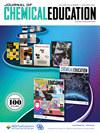猫砂对氨吸附性能的评价
IF 2.5
3区 教育学
Q2 CHEMISTRY, MULTIDISCIPLINARY
Journal of Chemical Education
Pub Date : 2025-04-03
DOI:10.1021/acs.jchemed.4c0140410.1021/acs.jchemed.4c01404
引用次数: 0
摘要
本实验采用自定义装置比较不同猫砂样品的氨吸附能力。氨在原位产生,随后被猫砂吸附。将多余的氨吸收到硼酸溶液中,通过差值法对硼酸溶液进行滴定,确定吸附氨的量。氨吸附量以每克猫砂的毫克数来量化。实验设计消除了直接处理气态氨的需要。这个动手练习可以让学生区分吸附和吸收的概念,并作为概念的实际应用,提高学生的积极性。本文章由计算机程序翻译,如有差异,请以英文原文为准。

Cat Litter Evaluation for Its Ammonia Adsorption Capacity
This laboratory experiment uses a custom setup to compare the ammonia adsorption capacity of different cat litter samples. Ammonia is generated in situ and subsequently adsorbed by the cat litter. Excess ammonia is absorbed in a boric acid solution, which is titrated to determine the amount of adsorbed ammonia through the difference method. The ammonia adsorption capacity is quantified in milligrams per gram of cat litter. The experimental design eliminates the need to handle gaseous ammonia directly. This hands-on exercise allows students to differentiate between the concepts of adsorption and absorption and serves as a practical application of the concepts, promoting motivation among students.
求助全文
通过发布文献求助,成功后即可免费获取论文全文。
去求助
来源期刊

Journal of Chemical Education
化学-化学综合
CiteScore
5.60
自引率
50.00%
发文量
465
审稿时长
6.5 months
期刊介绍:
The Journal of Chemical Education is the official journal of the Division of Chemical Education of the American Chemical Society, co-published with the American Chemical Society Publications Division. Launched in 1924, the Journal of Chemical Education is the world’s premier chemical education journal. The Journal publishes peer-reviewed articles and related information as a resource to those in the field of chemical education and to those institutions that serve them. JCE typically addresses chemical content, activities, laboratory experiments, instructional methods, and pedagogies. The Journal serves as a means of communication among people across the world who are interested in the teaching and learning of chemistry. This includes instructors of chemistry from middle school through graduate school, professional staff who support these teaching activities, as well as some scientists in commerce, industry, and government.
 求助内容:
求助内容: 应助结果提醒方式:
应助结果提醒方式:


